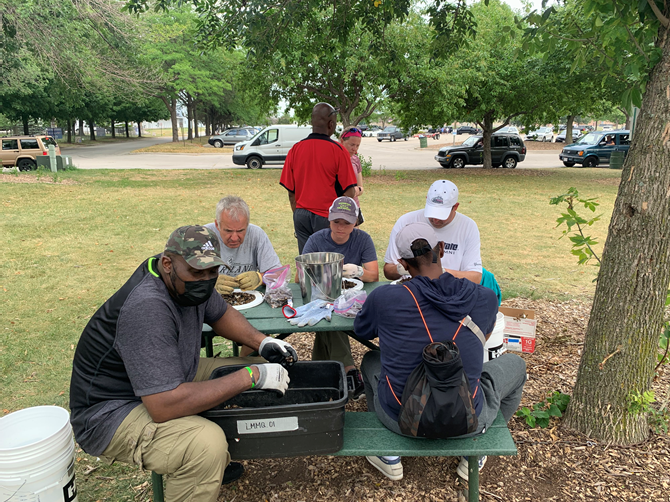
The Mussel Watch Program has monitored the nation’s coastal waters for chemical contaminants since 1986 and in recent decades has expanded its monitoring to include trace metals, legacy contaminants, and contaminants of emerging concern (CECs). In 2022, the program collected Dressenid mussel samples from a network of 90 sites in the Great Lakes. Results from this study will support a better understanding of the sources, fate, and transport of contaminants in the region and will fill important data gaps for local stakeholders.
Why We Care
As the largest body of freshwater on earth, the Great Lakes are a vital source of drinking water for millions of people, and they support multi-billion dollar fisheries and recreation industries. Thousands of chemical contaminants from many land-based point and nonpoint sources accumulate in the Great Lakes every day, compromising water quality and, consequently, threatening human and ecosystem health.
Previous studies in the region have investigated legacy contaminants, such as trace elements and persistent organic pollutants (e.g., polychlorinated biphenyls (PCBs), organochlorine pesticides, chlordane, and polycyclic aromatic hydrocarbons (PAHs)). These research and monitoring efforts have helped managers limit the impact that legacy contaminants have on coastal ecosystems, but such efforts are lacking for the increasing number of new and unregulated compounds known as contaminants of emerging concern (CECs), many of which are known to be harmful to people, animals, and the environment. In response to resource managers’ concerns about the extent and impact of these chemical stressors, the Mussel Watch Program conducted a basin-wide survey in 2022 to assess the magnitude and distribution of a suite of CECs, metals, and legacy contaminants in the Great Lakes.
What We Are Doing
The Mussel Watch Program uses an ecosystem-based approach to monitoring, which entails measuring the concentration of chemical contaminants in sediments and the tissues of indigenous bivalves, such as oysters and mussels, as a way to evaluate local environmental quality. Bivalves are used as indicator organisms for chemical pollution because they tend to bioaccumulate contaminants from the large amounts of water they filter, they have limited mobility, and they are found throughout the U.S. coastal zone.
The program currently analyzes sediment and bivalves for both legacy contaminants and CECs. Legacy contaminants, monitored by Mussel Watch since 1986, include compounds such as chlordanes, chlorobenzenes, dichlorodiphenyltrichloroethane (DDT), dieldrins, endosulfans, hexachlorocyclohexanes (HCHs), butyltins, PAHs, and PCBs. The monitoring of CECs began in 2009 and includes contaminants such as alkylphenols, alternative flame retardants, current-use pesticides, (per- and polyfluoroalkyl substances (PFASs), polybrominated diphenyl ether (PBDEs), polybrominated biphenyls (PBBs), and pharmaceuticals and personal care products. In general, CECs are minimally regulated, not commonly monitored, but potentially toxic chemicals that are finding their way into the environment.
In 2022, Mussel Watch analyzed sediment and Dressenid mussel samples a network of 90 sites in the Great Lakes for metals, legacy contaminants, and CECs. In this survey, 70 samples of Dressenid mussels and 25 of sediment were collected across Lakes Erie, Huron, Ontario, Michigan, Superior, and St. Clair following the standard Mussel Watch Program protocols. These sites were selected as a combination of long-term Mussel Watch Program monitoring sites and new targeted sites. The sites were chosen not only to assess the magnitude and distribution of chemical stressors in nearshore areas, but also, and more importantly, to evaluate the status and trends of chemical stressors in EPA’s designated areas of concern and the impacts of land-use categories on the distribution of chemical stressors in the survey area.
The national Mussel Watch Program designed the 2022 Great Lakes chemical stressors survey in collaboration with local and federal partners, including the NOAA Great Lakes Environmental Research Laboratory (GLERL), the U.S. Environmental Protection Agency’s (EPA’s) Great Lakes Restoration Initiative (GLRI) program, Lake-wide Action Monitoring Programs (LAMPs), and the U.S. Geological Survey (USGS).
Benefits of Our Work
Results of this study will help fill critical data gaps defined in GLRI Action Plan III focus area 1.3: to “increase knowledge about Great Lakes Water Quality Agreement Annex 3 chemicals in the Great Lakes.” Data from this survey will support ongoing projects on ecotoxicity of CECs that use available bioactivity data in the USEPA ToxCast database and the ToxEval and ToxMixtures softwares to prioritize contaminants and locations and to define potential environmental health implications. It is also anticipated that data from this survey will be leveraged with other watershed and tributary survey results from EPA and USGS to provide a holistic “summit-to-sea” assessment of chemical contamination in the Great Lakes. A “summit-to-sea” assessment helps identify land-based sources and their impacts to better understand hot spots of pollution.
This study supplies much-needed data to the national Mussel Watch Program and local stakeholders and managers in the Great Lakes region and informs water quality data used by coastal resource managers to develop effective, long-term policies to protect ecosystem services provided by the Great Lakes.

